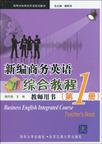新编商务英语综合教程·教师用书(第1册)
出版时间:2009-11 出版社:清华大学出版社有限公司 作者:谢丹焰 编 页数:284
前言
《新编商务英语综合教程》是针对高等院校经贸和商务英语专业的学生、具有相应英语水平的商务工作者及英语爱好者编写的基础课系列教材之一。本教程突破了传统的教材模式,综合考虑了高等院校经贸和商务英语专业学生的特点,以专业英语(ESP)的教学原则为指导,以现代外语教育对教材的意义和功能的更新理念为依托,力求以人为本,以任务为路径,以交际为目的,将商务英语技能的培养和相关学科专业知识的学习科学地结合起来,使学生在学习和掌握商务类专业基础知识的同时,深化英语学习,提高语用能力。 为了适应商务英语教学,紧扣时代脉搏,满足社会需要的发展趋势,本教程的编写人员在听取、汇总来自语言教学专家、商务专业人士和教学一线的广大师生的意见和建议的基础上,结合国外相关教学领域最新的研究成果,在内容的编排、材料的选择、题型的设计和结构的完善等方面进行了大量的创新性探索。 本教程在编写上主要体现了以下特点。 1.丰富性。本教程课文精选自世界著名商务英语报刊、杂志、网站及学术刊物,内容涵盖当今国际经济贸易和商务的各个重要领域,如商业文化、企业管理、经济全球化、信息技术、市场竞争、国际营销和国际金融等。选材还充分考虑了文章内容所涉及的区域性,包括世界经济中最具代表性的国家、区域和经济体。另外,选材也特别注重内容的时效性、典型性、专业性和语言质量,以最新、最典型的商务语言传递最新的国际商务信息。 2.多样性。本教程的编写兼顾了社会需求、专业培养目标、学生的认知程度和语言技能,在口语、阅读、词汇、翻译和写作几个方面均精心设计了形式各异的练习。每单元提供主、副两篇课文,练习包括与课文相关的阅读理解及围绕重点词汇和词组的词汇练习及翻译练习等。结合单元商务主题设计的口语活动包括双人讨论、角色扮演、小组讨论、大组汇报、模拟活动、班级辩论和个案讨论等课堂活动及相应的书面练习。此外,还设计了包括商务词汇、实用阅读、翻译技巧和写作策略几个模块的扩展练习,以便教师根据实际需要,有选择地组织课堂教学。 3.实用性。本教程的编写注重以点带面,侧重实用。每单元重点讨论、分析一个专题。通过大量来自公共媒体、公共场所、某些企业、公司及因特网的数据、图表和案例等真实的语料,结合商务活动诸多层面中遇到的具体语境,为学生提供真实的语言输入与输出环境,激发其想像力和发散性、创造性思维,真切地掌握英语语言基础知识,同时熟悉商务实践的技能、策略及相关的现实商务活动的真实场景。
内容概要
《新编商务英语综合教程》是“高等学校商务英语系列教材”之一。本书为第1册的教师用书,共10个单元,主要内容包括单元教学目标、背景知识、语言点讲解及课后练习答案。 本教程选材新颖,内容丰富,专业面广,实用性强,可供高等院校经贸和商务英语专业的学生、具有相应英语水平的商务工作者及英语爱好者学习使用。
书籍目录
Unit 1 Business Etiquette Ⅰ Teaching Objectives Ⅱ Background Information Ⅲ Language Focus Ⅳ Key to ExercisesUnit 2 Shopping Ⅰ Teaching Objectives Ⅱ Background Information Ⅲ Language Focus Ⅳ Key to ExercisesUnit 3 Companies Ⅰ Teaching Objectives Ⅱ Background Information Ⅲ Language Focus Ⅳ Key to ExercisesUnit 4 Products Ⅰ Teaching Objectives Ⅱ Background Information Ⅲ Language Focus Ⅳ Key to ExercisesUnit 5 Promotion Ⅰ Teaching Objectives Ⅱ Background Information Ⅲ Language Focus Ⅳ Key to ExercisesUnit 6 Job Interviews Ⅰ Teaching Objectives Ⅱ Background Information Ⅲ Language Focus Ⅳ Key to ExercisesUnit 7 Cultural Diversity Ⅰ Teaching Objectives Ⅱ Background Information Ⅲ Language Focus Ⅳ Key to ExercisesUnit 8 Managers Ⅰ Teaching Objectives Ⅱ Background Information Ⅲ Language Focus Ⅳ Key to ExercisesUnit 9 Going Global Ⅰ Teaching Objectives Ⅱ Background Information Ⅲ Language Focus Ⅳ Key to ExercisesUnit 10 Retailing Ⅰ Teaching Objectives Ⅱ Background Information Ⅲ Language Focus Ⅳ Key to Exercises
章节摘录
Above the line promotion—— Promotion in the media (e.g. TV, radio, newspapers, Intemet and mobile phones) in which the advertiser pays an advertising agency to place the ad. Below the ,line promotion —— All other promotion. Much of this is intended to be subtle enough for the consumer to be unaware that promotion is taking place, such as sponsorship, product placement, endorsements, sales promotion, merchandising, direct mail, personal selling, public relations, and trade shows. 3. Promotional Mix There are four main aspects of a promotional mix that specifies how much attention to pay and how much money to budget for each of them. Advertising- Any paid presentation and promotion of ideas, goods, or services by an identified sponsor. Examples: print ads, radio, television, billboard, direct mail, brochures and catalogs, signs, in-store displays, posters, motion pictures, Web pages, banner ads, and e-mails. Personal Selling —— A process of helping and persuading one or more prospects to purchase a good or service or to act on any idea through the use of an oral presentation. Examples: sales presentations, sales meetings, sales training and incentive programs for intermediary salespeople, samples, and telemarketing. Promotions —— Incentives designed to stimulate the purchase or sale of a product, usually in the short term. Examples: coupons, sweepstakes, contests, product samples, rebates, tie-ins, self-liquidating premiums, trade shows, trade-ins, and exhibitions. Public Relations ~ Paid intimate stimulation of supply for a product, service, or business unit by planting significant news about it or a favorable presentation of it in the media. Examples: newspaper and magazine articles/reports, TVs and radio presentations, charitable contributions, speeches, issue advertising, and seminars. 4. Promotion Plan A promotion plan outlines the promotional tools or tactics you plan to use to accomplish your marketing objectives. To the new or inexperienced marketer, the promotion plan might be mistaken as the entire marketing plan because it outlines where the majority of the marketing budget will be spent. It is, however, just one component of the marketing plan. You might choose to include the following components in your promotion plan. Description (or listing) of the promotional tactics you plan to use. Projected costs for the year. Explanation of how your promotion tactics will support your marketing objectives. Description of promotional adjustments for cyclical businesses, if yours is indeed cyclical. 5. Promotional "lactics The major component to your promotion plan is the description (or listing) of the planned promotional tactics you plan to use.
图书封面
评论、评分、阅读与下载
